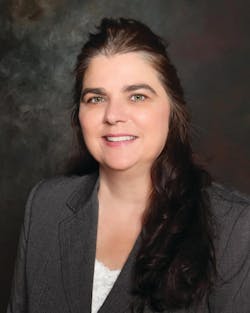An OSHA officer is in your lobby. Now what?
One Monday morning, I arrived at our dental office after spending a long, relaxing weekend enjoying the fall colors along the Blue Ridge Parkway. We completed the morning huddle, and I seated my first patient. I was conversing with my patient—catching up on the recent events of her life—when the receptionist appeared in my doorway. Tucked in her hand was a white business card. I thought a sales representative was in the reception area, so I instructed the receptionist to ask him to return at another time. I did not want to get behind this early in the day.
But I sensed urgency in the receptionist’s voice when she said, “I believe you will want to take time to speak with Mrs. Christine.”
I excused myself and glanced at the business card. There in bold letters was O-S-H-A. I laughed, thinking this was a joke on the part of my staff, but one glance into the eyes of my receptionist was all it took for me to quickly realize it was not a joke. My worst nightmare—an Occupational Safety and Health Administration (OSHA) compliance officer—had appeared in my office! Timorously, I asked my receptionist to have Mrs. Christine take a seat in the lobby and tell her I would be out to speak with her soon.
As I walked through the office, I notified my team members that a compliance officer was on-site. This gave me a few minutes to gather my composure and recall the information I had learned in annual training sessions. Now, the time had come; I had to put my training into action. Game on! I called Mrs. Christine into our office.
“Hi, Mrs. Christine, my name is Lori. How may I assist you?” and then, “Yes, ma’am, I will be glad to show you around our office, but first I must ask that you put on this safety gown.”
An OSHA inspector is in your office. What do you do? Would you be prepared if an inspector or compliance officer showed up at your office for a safety or health inspection? It is estimated that OSHA has jurisdiction over more than seven million jobsites,1 including dental and medical offices. An OSHA compliance officer can show up unannounced to conduct either a safety or health inspection. Compliance officers are either trained in safety hazards or health hazards; some are trained in both.1 A safety inspector or a health inspector will show up to conduct an inspection. To maintain compliance, dental offices must conduct annual training to assure that staff members are trained in ways that reduce job hazards and prevent injuries and illnesses.
Typical OSHA inspections are aimed at industries known to be a high risk for injury or death, and for workplaces known to experience high rates of illness or injuries.1 Dental and medical office inspections are occurring more frequently as manufacturing facilities decrease across the United States. Other incidents that can trigger an inspection are severe illness or injury, worker complaints, referrals of hazards from state or other federal agencies, and follow-up inspections.1
When an OSHA compliance officer presents in a dental or medical office, the office has a responsibility to maintain the confidentiality of patients. OSHA inspectors are aware of this and will comply with confidentiality demands and protect trade secrets. They cannot enter an operatory where a patient is being treated without consent of the patient. One exception is if the compliance officer believes that there is imminent danger of an employee injury, which is not likely to occur in a dental office.
What to expect during an OSHA inspection
A typical OSHA inspection will begin without your knowledge that your office has been selected. The compliance officer will receive notification of an impending site visit, which allows preparation time for the inspection. Prior to arriving on-site, compliance officers will use several sources to research the inspection history of the site.1 They will review the nature of the business, providing there is a familiarity of the industry and knowledge of the OSHA standards needed for the inspection. Upon arrival at your office, compliance officers are required to present their credentials. This includes a badge with a photo and an OSHA identification serial number.
Once the compliance officer has been verified, he or she will begin with an “opening conference,” followed by other specific elements of an OSHA inspection (see table 1). During the opening conference, the compliance officer will disclose the reason for the inspection, explain how the employer will be represented, and discuss employee interviews.1
Following the opening conference, the employer will select a representative of the practice who will accompany the compliance officer during a “walk-around.” Most often, this person is the practice’s infection control coordinator (ICC). During the walk-around, the OSHA compliance officer will be looking for safety and health hazards in the office that could lead to an employee injury or illness.
Once the walk-around is complete, the compliance officer will conduct employee interviews and hold a “closing conference.” The employer (dentist- owner), the employee representative (ICC), and the OSHA officer will discuss any violations that were discovered during the walk-around or during employee interviews. This will include possible actions that the employer must take, such as posting of citations, making a request for informal conferences, or formal challenges of citations and penalties.1
What can the OSHA compliance officer request during an inspection?
As a place of employment in the United States, your employer must comply with the General Duty Clause, Section 5(a)(1) of the Occupational Safety and Health Act, which requires that each employer furnish its employees with a workplace that is free from recognized hazards that have caused or are likely to cause death or serious physical harm2 or standards designed for specific industries. In dentistry, there are several standards to which we must adhere: the Bloodborne Pathogen Standard (29 CFR 1910.1030), Hazard Communication Standard (29 CFR 1910.1200), Ionizing Radiation (29 CFR 1910.1096), Exit Routes (29 CFR Subpart E 1910.35, 1910.36, 1920.38, and 1910.39), Electrical (Subpart S-electrical 29 CFR 1010.301 to 29 CFR 1910.399), and required OSHA poster (publication 3165) or your state equivalent. An OSHA compliance officer may request documentation and training records pertaining to any of the required standards.
In 2015, OSHA added key hazards for compliance officers to focus on during health-care inspections. These included an emphasis on musculoskeletal disorders, bloodborne pathogens, workplace violence, tuberculosis, and slips, trips, and falls. Your OSHA compliance manual should include specific policies regarding each of these.
During an inspection, be prepared to provide the compliance officer with annual training documents and records. This includes, but is not limited to, documentation of employee vaccinations or refusals, copies of the OSHA manual including the Bloodborne Pathogen Standard, safer sharps review forms, exposure-control incident reports, eyewash station and fire extinguisher test logs, evacuation plans, and an organized file of safety data sheets.
Remain calm and confident throughout the inspection
Greet the inspector in a friendly manner, being cautious not to become defensive or appear annoyed. An inspector may call attention to apparent violations during the walk-around that can be corrected immediately, showing good faith.1 Do not take this personally or become agitated at the compliance officer. Not all identified observations become citations. One important thing to remember is that you should never volunteer any information; let the compliance officer ask the questions. Discuss or answer specific questions that the compliance officer asks of you or other employees. Compliance officers are only allowed to view the information they request, although they may gather any information that you volunteer. That evidence could prompt a more in-depth inspection. Remember, some compliance officers are trained to inspect health hazards or safety hazards, and some are trained to recognize and inspect both. Knowing which branch of OSHA the compliance officer represents will help you to know the focus of your particular inspection.
If you notice the officer stop during the walk-around to take a photo, position yourself so that you are seeing exactly what the officer is seeing. Stop and take a photo from the same angle so that you can recall what the officer was seeing. This may become an asset to you and your employer during a meeting or formal hearing in the event of a citation that carries a fine or penalty.
Employee interviews
The compliance officer will request interviews with several employees of the practice. The owner of the workplace or the ICC will not be allowed to be present during employee interviews. This is to ensure that the employees feel safe in their work environment and do not feel pressured to answer questions according to expectations from their employer.
For example, during our inspection, employees were asked if they knew where extra personal protective equipment (PPE) was stored and if they felt that they had adequate supplies of PPE provided to them. They were also asked to demonstrate the one-hand scoop technique for recapping needles and locate the safety data sheets. As an OSHA officer, I was asked to provide hepatitis B and vaccination records for our staff members, the layout of our office (including the number of employees), a safety data sheet for oxygen, employee vaccination records, and documentation from our last OSHA training session.
Owner interview
As the owner and dentist, the OSHA compliance officer would not interview me as an employee, even though in our office I am an employee of my corporation. In fact, I had limited interactions with the compliance officer until the final conference.
Since our office did not have any infractions, our final conference was conducted on the same day as our inspection. In the final conference, I asked the officer why she refused to interview me as an employee. She stated that she felt that I would know how to “answer” the questions.
In closing
Are you prepared if an OSHA compliance officer shows up in your office? Would your office pass an inspection without citations or fines? An OSHA compliance officer could be randomly selected to inspect your office on any given day. Conducting frequent mock inspections or walk-throughs can keep you and your staff prepared in the event an OSHA officer appears in your reception room.
Keep thorough notes, logs, and maintain current written policy manuals. When you update materials, equipment, or change procedures, be sure to update your manuals as well. Compliance officers will use your office-specific manuals to evaluate your performance. Conduct annual training and document the content of the training. Maintain these records for three years. Verify that your safety data sheets are up-to-date and easily retrieved, either in print or electronically. If your office practices compliance on a daily basis, not only does it protect you and your fellow employees from harm, but it also prepares you for that unexpected, dreaded visit from an OSHA compliance officer.
References
1. OSHA fact sheet. Occupational Safety and Health Administration (OSHA) inspections. US Department of Labor Occupational Safety and Health Administration website. https://www.osha.gov/OshDoc/data_General_Facts/factsheet-inspections.pdf.
2. OSH Act of 1970. General Duty Clause. US Department of Labor Occupational Safety and Health Administration website. https://www.osha.gov/laws-regs/oshact/section5-duties.
About the Author

Joseph R. Hendrick Jr., DDS
JOSEPH R. HENDRICK JR., DDS, is a licensed dentist with more than 35 years of experience in providing clinical dental care. He is active in organized dentistry in North Carolina as a past president of his local dental society, and as a current board of trustee member of the North Carolina Dental Society. He enjoys sharing his knowledge of dentistry with new dentists and hygienists and serving as a mentor to new graduates. He may be reached at [email protected] or josephrhendrickjr.com.

Lori Gordon Hendrick, PhDc, MS, RDH, CDA, CDT
Lori Hendrick, PhDc, MS, RDH, CDA, CDT, is working toward a PhD in public administration and policy with a concentration in health policy at Old Dominion University. In addition to practicing dental hygiene, she owns Athena Dental Solutions and teaches clinical hygiene and professional development at Central Piedmont Community College. She’s a past president of the North Carolina Dental Hygiene Association, a consultant on the North Carolina Dental Society Work Force Task Force, and on the board of directors for North Carolina Caring Dental Professionals. Email Lori at [email protected].
Updated February 4, 2022



